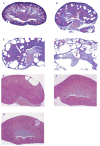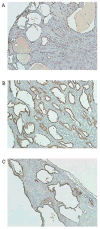Inactivation of Pkd1 in principal cells causes a more severe cystic kidney disease than in intercalated cells
- PMID: 19145237
- PMCID: PMC3879111
- DOI: 10.1038/ki.2008.659
Inactivation of Pkd1 in principal cells causes a more severe cystic kidney disease than in intercalated cells
Abstract
Renal cysts in autosomal dominant polycystic kidney disease arise from cells throughout the nephron, but there is an uncertainty as to whether both the intercalated cells (ICs) and principal cells (PCs) within the collecting duct give rise to cysts. To determine this, we crossed mice containing loxP sites within introns 1 and 4 of the Pkd1 gene with transgenic mice expressing Cre recombinase under control of the aquaporin-2 promoter or the B1 subunit of the proton ATPase promoter, thereby generating PC- or IC-specific knockout of Pkd1, respectively. Mice, that had Pkd1 deleted in the PCs, developed progressive cystic kidney disease evident during the first postnatal week and had an average lifespan of 8.2 weeks. There was no change in the cellular cAMP content or membrane aquaporin-2 expression in their kidneys. Cysts were present in the cortex and outer medulla but were absent in the papilla. Mice in which PKd1 was knocked out in the ICs had a very mild cystic phenotype as late as 13 weeks of age, limited to 1-2 cysts and confined to the outer rim of the kidney cortex. These mice lived to at least 1.5 years of age without evidence of early mortality. Our findings suggest that PCs are more important than ICs for cyst formation in polycystic kidney disease.
Figures










Similar articles
-
Pkd1 inactivation induced in adulthood produces focal cystic disease.J Am Soc Nephrol. 2008 Dec;19(12):2351-63. doi: 10.1681/ASN.2007101139. Epub 2008 Sep 5. J Am Soc Nephrol. 2008. PMID: 18776127 Free PMC article.
-
Cux1 promotes cell proliferation and polycystic kidney disease progression in an ADPKD mouse model.Am J Physiol Renal Physiol. 2017 Oct 1;313(4):F1050-F1059. doi: 10.1152/ajprenal.00380.2016. Epub 2017 Jul 12. Am J Physiol Renal Physiol. 2017. PMID: 28701314 Free PMC article.
-
Ectopic expression of Cux1 is associated with reduced p27 expression and increased apoptosis during late stage cyst progression upon inactivation of Pkd1 in collecting ducts.Dev Dyn. 2011 Jun;240(6):1493-501. doi: 10.1002/dvdy.22625. Epub 2011 Apr 4. Dev Dyn. 2011. PMID: 21465620 Free PMC article.
-
[Pathogenesis of cystic kidney diseases].Verh Dtsch Ges Pathol. 2002;86:138-44. Verh Dtsch Ges Pathol. 2002. PMID: 12647363 Review. German.
-
Current advances in molecular genetics of autosomal-dominant polycystic kidney disease.Curr Opin Nephrol Hypertens. 2001 Jan;10(1):23-31. doi: 10.1097/00041552-200101000-00005. Curr Opin Nephrol Hypertens. 2001. PMID: 11195048 Review.
Cited by
-
Macrophage migration inhibitory factor is regulated by HIF-1α and cAMP and promotes renal cyst cell proliferation in a macrophage-independent manner.J Mol Med (Berl). 2020 Nov;98(11):1547-1559. doi: 10.1007/s00109-020-01964-1. Epub 2020 Sep 4. J Mol Med (Berl). 2020. PMID: 32885302 Free PMC article.
-
Adenylyl cyclase 6 deficiency ameliorates polycystic kidney disease.J Am Soc Nephrol. 2014 Feb;25(2):232-7. doi: 10.1681/ASN.2013010077. Epub 2013 Oct 24. J Am Soc Nephrol. 2014. PMID: 24158982 Free PMC article.
-
Modeling Pkd1 gene-targeted strategies for correction of polycystic kidney disease.Mol Ther Methods Clin Dev. 2023 Apr 3;29:366-380. doi: 10.1016/j.omtm.2023.03.016. eCollection 2023 Jun 8. Mol Ther Methods Clin Dev. 2023. PMID: 37214311 Free PMC article.
-
Pkd2 Deficiency in Embryonic Aqp2 + Progenitor Cells Is Sufficient to Cause Severe Polycystic Kidney Disease.J Am Soc Nephrol. 2024 Apr 1;35(4):398-409. doi: 10.1681/ASN.0000000000000309. Epub 2024 Jan 23. J Am Soc Nephrol. 2024. PMID: 38254271 Free PMC article.
-
Mechanistic complement of autosomal dominant polycystic kidney disease: the role of aquaporins.J Mol Med (Berl). 2024 Jun;102(6):773-785. doi: 10.1007/s00109-024-02446-4. Epub 2024 Apr 26. J Mol Med (Berl). 2024. PMID: 38668786 Review.
References
-
- Huseman R, Grady A, Welling D, et al. Macropuncture study of polycystic disease in adult human kidneys. Kidney Int. 1980;18:375–385. - PubMed
-
- Bachinsky DR, Sabolic I, Emmanouel DS, et al. Water channel expression in human ADPKD kidneys. Am J Physiol. 1995;268:F398–F403. - PubMed
-
- Hayashi M, Yamaji Y, Monkawa T, et al. Expression and localization of the water channels in human autosomal dominant polycystic kidney disease. Nephron. 1997;75:321–326. - PubMed
-
- Kovacs J, Zilahy M, Gomba S. Morphology of cystic renal lesions. Lectin and immuno-histochemical study. Acta Chir Hung. 1997;36:176–178. - PubMed
-
- Yoder BK, Mulroy S, Eustace H, et al. Molecular pathogenesis of autosomal dominant polycystic kidney disease. Expert Rev Mol Med. 2006;8:1–22. - PubMed
Publication types
MeSH terms
Substances
Grants and funding
LinkOut - more resources
Full Text Sources
Other Literature Sources
Medical
Molecular Biology Databases

